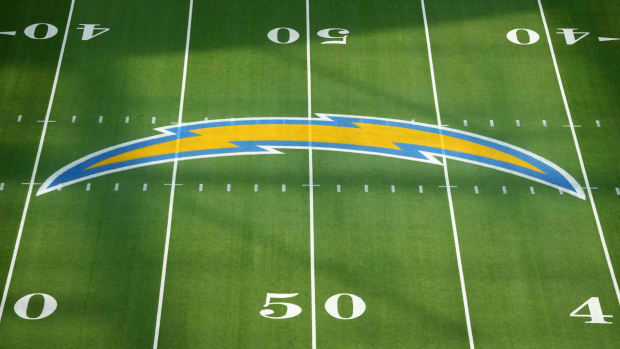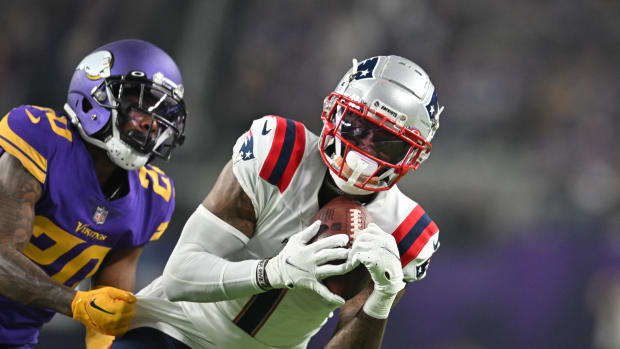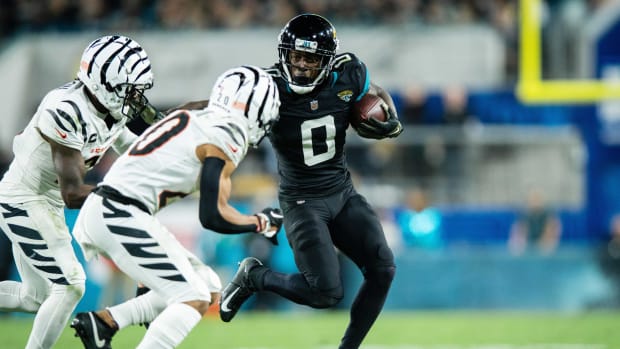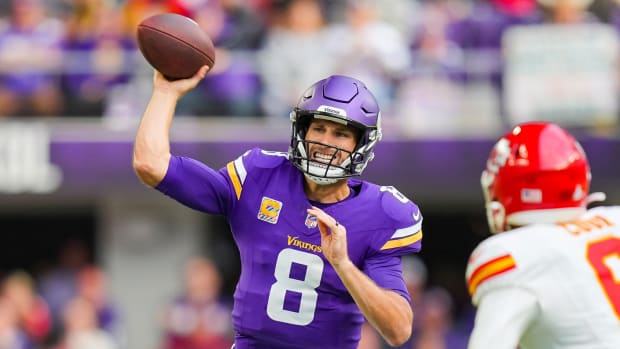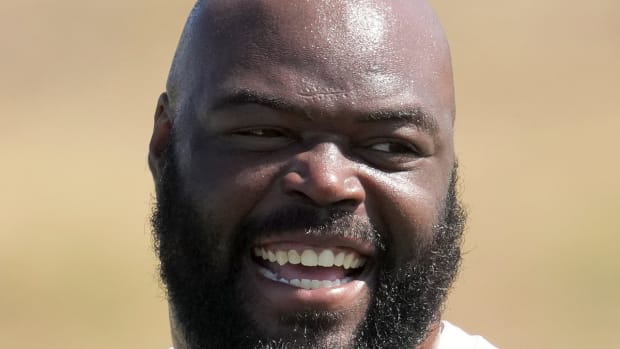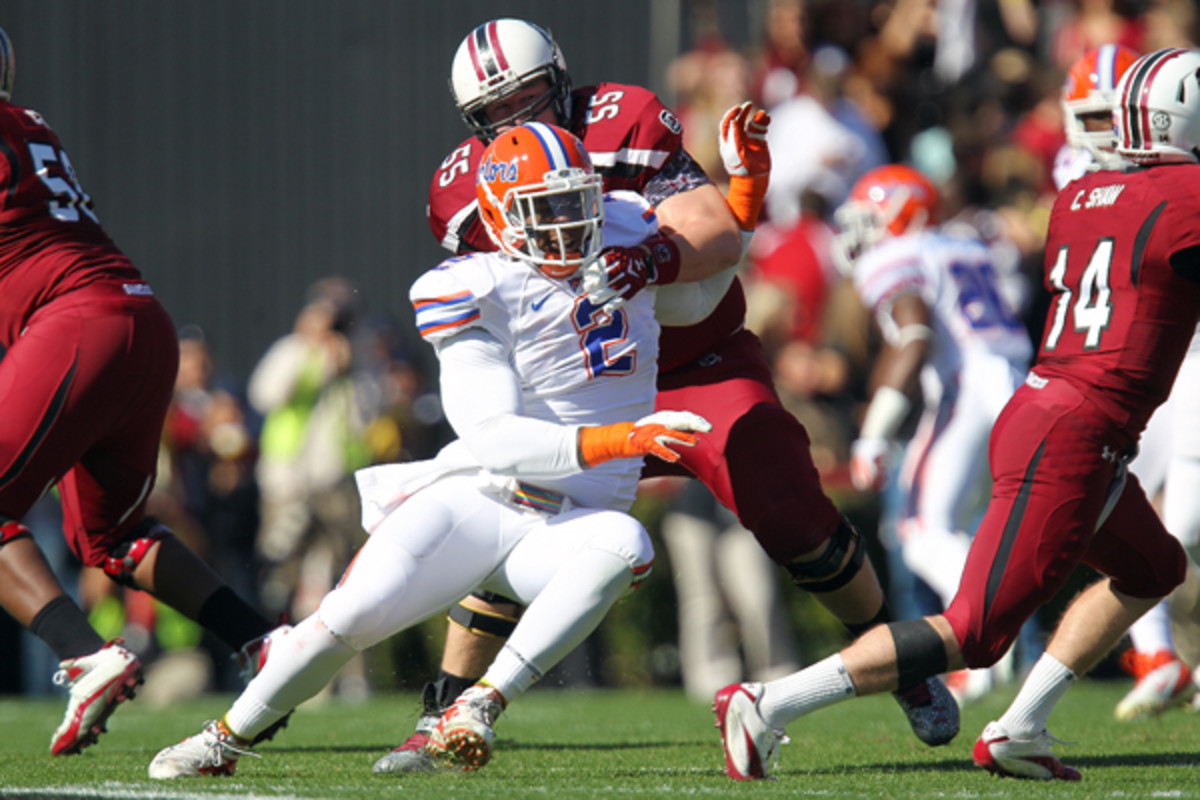
Break it Down: Dominique Easley could redefine New England's defensive fronts
In college, the only way to stop a healthy Dominique Easley was to hold him. (Phelan M. Ebenhack/AP)
For a guy who played in just three games and amassed five tackles in 2013, Florida defensive lineman Dominique Easley certainly did a fine job of upsetting the bottom end of the 2014 draft's first round. When he was selected 29th overall by the Patriots, the Seahawks -- who were looking hard at Easley with the 32nd pick -- traded out of the first round and allowed the Minnesota Vikings to take Teddy Bridgewater there. Bill Belichick, whose history with hybrid pass-rushers goes back to his time as the Giants' special teams and linebackers coach in 1981 (and his work with a promising rookie named Lawrence Taylor), talked about Easley's possible roles in New England's defense with more effusiveness than one usually sees.
"He’s played everywhere along the defensive line," the coach said on May 8, just after the first round wrapped up. "It depends on where you put him. I’ll say you don’t see a lot of guys who do that – who play, I mean, he lines up on the nose, he lines up on the guard, he lines up on the tackle, he lines up out wide at times. You can see him playing all those spots... He does a lot of things well. He’s a smart guy, he’s very instinctive. He’s got a great motor, works hard. Football is very important to him. He’s an all-in guy. There’s not much to not like about him."
More: Fallout from the Kaepernick deal | Offseason Report Cards | NFL Power Rankings
The tape more than backs up the hype, and we'll get to that in a moment. The only thing that brings pause, of course, is that Easley suffered injuries to the ACLs in both knees through his collegiate career. Both injuries were non-contact in nature, and most analysts believe that had those injuries not happened, and Easley had been able to play at his collegiate level, he would have been a top-10 pick. I'd go a step further and say that if Easley had been injury-free at Florida, he might have been the first player taken overall; at the very least, the discussion regarding the best defensive player in this draft class would have been far more interesting. But Easley was under the radar in a relative sense, and he had to wait until the end of the first round. That's how it goes -- Florida State defensive end Tank Carradine would have absolutely been a first-round pick in 2013 but for the torn ACL he suffered on Nov. 24, 2012. Instead, Carradine fell to the ninth pick in the second round, where the 49ers took him, and he hasn't yet played in an NFL game.
Easley believes his situation is different.
“I tore my ACL in 2011, and I got faster in 2013,” Easley said at the scouting combine. “So when I get back from this ACL, it’s going to make me nothing but faster… it’s a blessing for me because I know what I went through, how much I improved after the first ACL.”
What makes Easley special? As Belichick said, he plays multiple defensive line positions at a ridiculously high level. And for a defensive mind such as Belichick's, he's a perfect cog in a lot of ways. Belichick has been blurring the lines between 3-4 and 4-3 gap concepts long before they were the standard in the NFL; he wants players who can fit in all sorts of line gaps and disrupt no matter where they're lined up. Easley doesn't have a lot of tape from 2013, but what there is shows that he's clearly this kind of player.
On Sept. 21 against Tennessee, Easley lined up as a five-tech end in Florida's three-man fronts, and as a three-tech and nose tackle in four-man fronts. And there were times when he was unstoppable from all of those spots. The play illustrated below came with 3:31 left in the first quarter. The Vols had the ball at their own 12-yard line with third-and-9, and quarterback Nathan Peterman was in trouble from the start. Before the snap, Easley motioned from end to straight over the right guard, and simply blew past the blocking with a quick swim move. He was on Peterman quickly, though right end Dante Fowler Jr. got there first. It was a perfect example of how Easley creates disruption from outside, whether he's playing one-gap and penetrating (which would generally be easier for a 6-2, 285-pound lineman) or playing two-gap, and having to react to blocks.
Those wondering how Easley might fare straight over a center outweighing him by a few pounds need look no further than this play against the Miami Hurricanes on Sept. 7. Easley was going up against Shane McDermott, who made the All-ACC third team in 2014 and has been on more than one Rimington Trophy Spring Watchlist, an early forecast for the player who might win the award given annually to the best center in college football. But on this play, with eight minutes left in the first quarter, the 6-3, 296-pound McDermott was made to look like a scrub as Easley came off the snap straight overhead. Easley's initial hand-strike pushed McDermott back more than a yard and kept moving him backward. The momentum of the play caused Easley to hit the ground as he closed in on quarterback Stephen Morris, but he was able to get up for a pressure, and a roughing the passer call against him.
As I pointed out in his SI 64 scouting report, Easley’s most prominent attribute is that he can play convincingly and at a starter level in so many gaps. There are multiple examples of him blowing up protections everywhere. He even has the speed and turn to disrupt from a wide-nine stance. For his size, Easley flashes tremendous upper-body strength — he plays 20 or 30 pounds heavier than he is in that sense, but he has the field speed and agility of a linebacker when he’s in space or covering in short areas. Gets his hands on blockers right off the snap and uses his hands very well — will use hand-strikes, swim and rip moves, and pure bull-rushes to drive through or get past to the backfield. Didn’t do a lot of stunting and looping for the Gators, but he clearly has the skillset to do so. And when he's lined up in a stunt formation (at a 45-degree angle against the line), Easley is just about unblockable because he gets through with such explosive speed.
And it's his positional versatility that makes him so appealing to the Patriots in their current defensive iterations.
In 2013, the Patriots spent most of their time in a nickel defense with a four-man front -- per Football Outsiders, they rushed four linemen 65.6 percent of the time (10th in the league), and had five defensive backs on the field 58 percent of the time (eighth in the NFL, and 9 percent over league average). New England also rushed five 18.9 percent of the time, which ranked 25th.
The four-man front with a nickel defense has become en vogue as a base concept for one primary reason -- the stunning uptick in pass-first, no-huddle offenses over the last few seasons. In 2013, teams actually put five defensive backs on the field more often than they did four -- 49 percent to 40 percent -- and it was the second straight season that had happened, which is presumably NFL history. When you're playing a base defense against a high-volume aerial offense, you must have the requisite number and quality of pass-defenders on the field as well as the right number and quality of pass-rushers, and you must do so in a way that precludes defensive substitutions -- which, of course, the no-huddle is designed to stop.
In two games against the Denver Broncos last season (Week 12 and the AFC Championship Game), the Patriots lined up for 166 total defensive snaps. They sacked Peyton Manning once. They amassed three quarterback hits (none in the conference championship game) and 14 quarterback hurries. And this was a defense that ranked fifth in the league in sacks with 48. But the inability to adjust personnel against no-huddle was one of the things that kept New England out of the Super Bowl. Belichick didn't forget that Denver had 41 no-huddle snaps in the game that gave it the AFC crown.
“They did a good job of mixing up plays," Belichick said of the Broncos after that game. "As always, [Manning] did an excellent job of reading the defenses and he got us in some situations that were less than ideal with his astute play-calling and recognition. We disguised, and I think we got him a few times, but he certainly got us a few times, too. And they’ve got a lot of good players. They’re a tough team to match up against with all the skill players they have; backs, tight ends, receivers. They have, obviously a good football team, a good offensive system, and a good quarterback.”
The best way -- perhaps the only way -- to consistently counter an NFL no-huddle offense is to acquire players who have the ability to affect the passing game without substitutions. On the fly, moving to different gaps, and with multiple techniques. That's why the Patriots took the gamble on Easley.
"We're confident that he'll be able to return from the injury like almost everybody who's had an ACL has, so I don't think it's the type of injury that isn't pretty common in our league," Belichick told SIRIUS XM Radio in late May. "He's working hard to rehab and hopefully he'll be OK. I think when he is, we feel like we got good value for that pick."









































